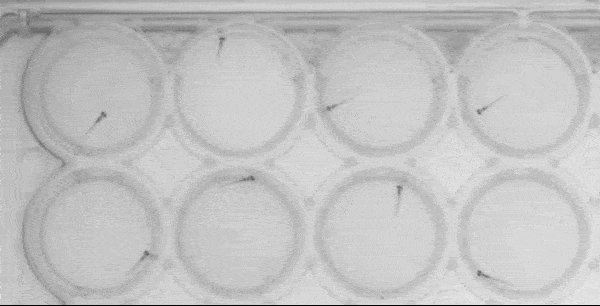Epilepsy Model
Epilepsy is characterized by recurrent, unprovoked seizures that result from excessive and hypersynchronous electrical discharges in the brain. Exposure to the common convulsant agent pentylenetetrazole (PTZ) induces a stereotyped, and concentration-dependent sequence of behavioral changes culminating in convulsions in zebrafish larvae. This model allows for identifying compounds that prevent locomotor and convulsive behavioral alterations.
Applications
- High throughput screening of compounds with potential seizure-inducing activity.
- High throughput efficacy screening of new anti-epileptic or anticonvulsant drugs.
- Genetic functional studies of potential seizure-modulating genes (target validation).
Advantages
High conservation of zebrafish convulsive behavioral responses with mammals.
Zebrafish exposure to PTZ induces similar results in mammals physiologically and behaviourally, but thanks to the large zebrafish progenies we can test a high number of compounds simultaneously.
A comprehensive panel of behavioral outputs can be evaluated.
Automated locomotion monitoring rapidly highlights epilepsy phenotype rescue, identifying promising therapeutic compounds.
Method description
Zebrafish embryos are exposed to PTZ, to unchain seizures, together with the compound of interest. Behavior and seizures are assessed in treated larvae using the following experimental protocol to evaluate the anticonvulsant properties of compounds:
 Figure 1. Seizure behavioral protocol scheme. Blue arrows depict dark phases, whereas white arrows depict light phases.
Figure 1. Seizure behavioral protocol scheme. Blue arrows depict dark phases, whereas white arrows depict light phases.
Readouts
Benchmark Dose (BMD) of the compound of interest.
Behavioral assessments:
- Total spontaneous locomotion activity.
- Convulsive response in response to visual stimuli: maximum velocity and angle turn (change in direction).
- Anomalies in the stereotyped dark/light larval locomotion pattern.
Larval movement is tracked and analyzed by DanioVision™ software (Noldus IT).
 Figure 2. Spontaneous locomotion and response to visual stimuli. From left to right: Total distance moved in the initial 15-minute light phase, Maximum velocity and Angle turn (change in direction) in response to flashes of light (seizure characterization). PTZ-treated larvae show a general hyperactive phenotype (increased total distance moved). In this group the flash of light produces a fast-darting type of movement (increased maximum velocity), and increased number of turns (change in direction) compared to the negative control. The observed phenotype is rescued by the anti-convulsive compound. Means and SEM are plotted. **p<0,01; ***p<0,001.
Figure 2. Spontaneous locomotion and response to visual stimuli. From left to right: Total distance moved in the initial 15-minute light phase, Maximum velocity and Angle turn (change in direction) in response to flashes of light (seizure characterization). PTZ-treated larvae show a general hyperactive phenotype (increased total distance moved). In this group the flash of light produces a fast-darting type of movement (increased maximum velocity), and increased number of turns (change in direction) compared to the negative control. The observed phenotype is rescued by the anti-convulsive compound. Means and SEM are plotted. **p<0,01; ***p<0,001.
 Figure 3. Videotracking of larval response to a seizure-inducing visual stimulus acquired by Daniovision™ device (Noldus IT). Larvae from the first two columns are treated with the negative control, while those from the last two columns are treated with PTZ. Red dot depicts the moment when the flash of light has occurred. Subsequently, PTZ-treated larvae begin to convulse.
Figure 3. Videotracking of larval response to a seizure-inducing visual stimulus acquired by Daniovision™ device (Noldus IT). Larvae from the first two columns are treated with the negative control, while those from the last two columns are treated with PTZ. Red dot depicts the moment when the flash of light has occurred. Subsequently, PTZ-treated larvae begin to convulse.
 Figure 4. Light/dark larvae locomotion per minute. PTZ induces the reversion of the stereotyped activity of larvae under different light environments. Thus, whereas DMSO-treated larvae are highly active in short periods of darkness and are almost immotile during short periods of light, PTZ-treated larvae increase their activity in light environment and decrease it in dark. Means and SD are plotted.
Figure 4. Light/dark larvae locomotion per minute. PTZ induces the reversion of the stereotyped activity of larvae under different light environments. Thus, whereas DMSO-treated larvae are highly active in short periods of darkness and are almost immotile during short periods of light, PTZ-treated larvae increase their activity in light environment and decrease it in dark. Means and SD are plotted.
We'd like to hear from you
If you want more information about our epilepsy
models or have any other questions, please
contact our experts.
References
- Baraban SC, Taylor MR, Castro PA, Baier H. Pentylenetetrazole induced changes in zebrafish behavior, neural activity and c-fos expression. Neuroscience. 2005;131(3):759-68.